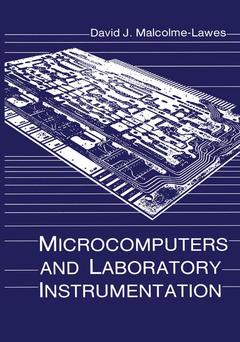Microcomputers and Laboratory Instrumentation, Softcover reprint of the original 1st ed. 1984
Langue : Anglais
Auteur : Malcolme-Lawes David J.

The invention of the microcomputer in the mid-1970s and its subsequent low-cost proliferation has opened up a new world for the laboratory scientist. Tedious data collection can now be automated relatively cheaply and with an enormous increase in reliability. New techniques of measurement are accessible with the "intelligent" instrumentation made possible by these programmable devices, and the ease of use of even standard measurement techniques may be improved by the data processing capabilities of the humblest micro. The latest items of commercial laboratory instrumentation are invariably "computer controlled", although this is more likely to mean that a microprocessor is involved than that a versatile microcomputer is provided along with the instrument. It is clear that all scientists of the future will need some knowledge of computers, if only to aid them in mastering the button pushing associated with gleaming new instruments. However, to be able to exploit this newly accessible computing power to the full the practising laboratory scientist must gain sufficient understanding to utilise the communication channels between apparatus on the laboratory bench and program within the computer. This book attempts to provide an introduction to those communication channels in a manner which is understandable for scientists who do not specialise in electronics or computers.
1 Introduction.- 1.1 Laboratory instrumentation and microcomputers.- 1.2 Measurement systems.- 1.3 Electronic black boxes.- 1.4 A practical footnote.- 2 The Basics of Laboratory Signals.- 2.1 Transducers.- 2.2 Measurement signals.- 2.3 The transducer connection.- 2.4 Noise and interference.- 2.5 Minimising interference.- 2.6 Signal-to-noise ratio.- 2.7 Control signals.- 3 The Elements of Analog Signal Handling.- 3.1 Op-amps.- 3.2 Feedback systems.- 3.3 Basic amplifier configurations.- 3.4 Bandwidth and slew rate.- 3.5 Practical dc signal circuits.- 3.6 Ac signal circuits.- 3.7 Integrators.- 3.8 Differentiators.- 3.9 Pulse amplifiers.- 3.10 Filters.- 4 The Elements of Digital Signal Handling.- 4.1 Logic gates.- 4.2 TTL families.- 4.3 CMOS families.- 4.4 CMOS and TTL together.- 4.5 MSI circuits.- 4.6 Generating logic levels.- 4.7 Analog/digital interconversion.- 4.8 Serial digital signals.- 5 The Modern Microcomputer.- 5.1 The eight bit micro.- 5.2 The programming language.- 5.3 The operating system.- 5.4 Peripherals.- 5.5 Byte handling busses.- 5.6 The video display.- 5.7 Bit manipulation.- 5.8 Timing and addressing.- 5.9 Interrupts and interrupt flags.- 5.10 The 16 bit micro.- 6 Interfacing Microcomputers with Laboratory Instrumentation.- 6.1 Basic instrumental interface types.- 6.2 Multiplexing.- 6.3 Multiple byte interfaces.- 6.4 Interface control.- 6.5 Handshaking.- 6.6 Synchronous byte transfers.- 6.7 Dynamic interfaces.- 7 Standard Interface Systems.- 7.1 Introduction.- 7.2 The IEEE 488 standard.- 7.3 The RS232C link.- 8 System Design.- 8.1 An approach to system design / Case study.- Appendices.- Appendix 1 Decimal-hexadecimal conversion tables.- Appendix 2 The ASCII code.- Appendix 3 Sample assembler routine for GPIB adaptor.- Device index.
Date de parution : 07-2012
Ouvrage de 246 p.
17.8x25.4 cm
Disponible chez l'éditeur (délai d'approvisionnement : 15 jours).
Prix indicatif 52,74 €
Ajouter au panierMots-clés :
Laboratory; communication; data processing; electronics; programming language
© 2024 LAVOISIER S.A.S.



